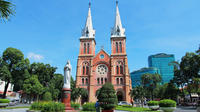Full Day Saigon City Tour Including Cu Chi Tunnels
Ho Chi Minh City, Vietnam
Trip Type: Full-day Tours
Duration: 1 day
Saigon, also known as Ho Chi Minh City, is not only a vital economic city but also a tourist one in the southern Vietnam. It has a wide variety of attractive destination system including 11 museums with thousands of artifacts; more than 1,000 pagodas, temples, shrines and Gothic, Roman styled churches. There are also a unique combination between many important architectural constructions remaining from the colonial period and modern buildings in the city. Experience a full day sightseeing tourist attractions around Saigon and explore Cu Chi Tunnels to learn how Vietnamese fought during the war.
More About This Activity All Full-day Tours →
Saigon, also known as Ho Chi Minh City, is not only a vital economic city but also a tourist one in the southern Vietnam. It has a wide variety of attractive destination system including 11 museums with thousands of artifacts; more than 1,000 pagodas, temples, shrines and Gothic, Roman styled churches. There are also a unique combination between many important architectural constructions remaining from the colonial period and modern buildings in the city. Experience a full day sightseeing tourist attractions around Saigon and explore Cu Chi Tunnels to learn how Vietnamese fought during the war.
Start the city tour at the Central Square, surrounded by the Saigon Notre-Dame Basilica, or Notre Dame Cathedral which was established by French colonists and built in between 1863 and 1880. This cathedral has 2 bell tower and most of original building materials importing from France.
Next, come to the Central Post Office nearby the city’s cathedral. This construction was built in the late of 19th century and affected by the Gothic, Renaissance and French architectural style.
Then visit Reunification Palace, also known as Independence Palace, the home and workplace of the president in Vietnam War before the Fall of Saigon on April 30 happened.
The fourth destination is Jade Emperor Pagoda (Ngoc Hoang Pagoda), located in the city centre and built by the Chinese community in 1909. This is an old pagoda with a variety of artistic works made from different materials.
Continue the trip to experience daily life of Saigon people at Ben Thanh Market in the Centre of district I, the most bustling one where . Enjoy lunch in a local restaurant.
In the afternoon, drive for Cu Chi Tunnels, one of the few remaining monuments of Vietnam War. Beneath the ground lie 200 km of tunnels, dug by hand and inhabited by the forces of the Vietnamese guerrillas during the conflict. At its peak, prior to the Tet Offensive in 1968, the tunnel complex was base to almost 10,000 troops. To this day, it remains one of the most impressive examples of how fierce the war used to be. Return to Saigon late afternoon.
Next, come to the Central Post Office nearby the city’s cathedral. This construction was built in the late of 19th century and affected by the Gothic, Renaissance and French architectural style.
Then visit Reunification Palace, also known as Independence Palace, the home and workplace of the president in Vietnam War before the Fall of Saigon on April 30 happened.
The fourth destination is Jade Emperor Pagoda (Ngoc Hoang Pagoda), located in the city centre and built by the Chinese community in 1909. This is an old pagoda with a variety of artistic works made from different materials.
Continue the trip to experience daily life of Saigon people at Ben Thanh Market in the Centre of district I, the most bustling one where . Enjoy lunch in a local restaurant.
In the afternoon, drive for Cu Chi Tunnels, one of the few remaining monuments of Vietnam War. Beneath the ground lie 200 km of tunnels, dug by hand and inhabited by the forces of the Vietnamese guerrillas during the conflict. At its peak, prior to the Tet Offensive in 1968, the tunnel complex was base to almost 10,000 troops. To this day, it remains one of the most impressive examples of how fierce the war used to be. Return to Saigon late afternoon.
« Go Back

